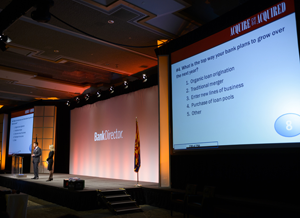
Desperately Seeking Loan Growth
 With no sign of relief anticipated from the Federal Reserve, low interest rates—and their effects on net interest margins—were top of mind for the audience at Bank Director’s 19th annual Acquire or Be Acquired conference in Scottsdale, Arizona, recently. During the audience response survey, conducted by Grant Thornton LLP and Bank Director at the end of the January, 35 percent of the 273 bank executives and directors who answered the survey said continued net interest margin compression was their top concern, while 25 percent cited loan demand.
With no sign of relief anticipated from the Federal Reserve, low interest rates—and their effects on net interest margins—were top of mind for the audience at Bank Director’s 19th annual Acquire or Be Acquired conference in Scottsdale, Arizona, recently. During the audience response survey, conducted by Grant Thornton LLP and Bank Director at the end of the January, 35 percent of the 273 bank executives and directors who answered the survey said continued net interest margin compression was their top concern, while 25 percent cited loan demand.
According to Jack Barrett, president and CEO of $216-million asset First Citrus Bank, headquartered in Tampa, Florida, concerns with the net interest margin and loan demand are connected. “Because of the dearth of organic loan demand, that engenders the margin compression,” says Barrett. John Paisley, region president with Adams Bank & Trust, a $550 million commercial bank based in Ogallala, Nebraska, says that while the bank is seeing strong loan demand due to a strong agricultural economy and increased real estate pricing, the bank must offer below market rates to compete, forcing his bank to “learn how to operate with less margin.”
What will loan demand look like in 2013? Fifty-seven percent of respondents expect to see an increase in loan demand in 2013, with 10 percent expecting to see a decline and one-third expecting no change. David H. Dunn, president and CEO of Wolverine Bancorp, Inc., a $284-million, publicly-traded bank holding company headquartered in Midland, Michigan, plans to fuel growth via organic loan origination, but also sees a challenge. “Everybody is looking for organic growth, and they’re doing it in an economy that’s not growing,” he says. Nichole Jordan, national banking and securities industry leader at Grant Thornton, agrees. “Growth will be hard to come by in 2013 without significant strides made in overall economic recovery,” says Jordan. Barrett sees a market that is “erratic”, but expects to see more loan demand in 2013. “I think it’s going to be more stable in terms of loan demand. I think there’s more certainty,” he says.
Bankers plan to address the challenges presented by loan demand in a variety of ways. Jeff Brotherson, chief financial officer of Two Rivers Financial Group, a $679-million bank holding company based in Burlington, Iowa, says that his bank focuses on hiring experienced loan producers. Data can help banks grow loans as well. Barrett supports using data analytics to better understand the market. Jordan agrees, adding that by investing in technology that allows for effective analysis and use of data, bank management teams can better monitor customer trends and be more proactive.
While 60 percent of bankers surveyed chose loan origination as their top plan for growth, 28 percent plan a traditional merger. Not everyone who wants to buy a bank will. In fact, 83 percent of bankers surveyed at the conference want to buy a bank in 2013, although the conference itself tends to attract people interested in acquisitions. For smaller banks looking to grow quickly, this could be a wise choice. Adams Bank & Trust plans to eventually double in size, likely via acquisition. “Through organic growth, I just don’t think we’re going to get there fast enough,” says Paisley.
Barrett is actively seeking a merger of equals in order to achieve some economies of scale, but the deal has to be right, in part due to capital concerns. ”In order to garner regulatory approval, you have to overcapitalize the transaction so high that our existing ROE [return on equity] would go down,” he says. “We are not about reducing our returns [to] shareholders.” Many of those surveyed don’t plan to raise capital, with 66 percent giving a flat “no” to raising capital over the next year, compared to 25 percent that plan to raise capital, and 9 percent that would like to raise capital, but aren’t certain of their ability to do so. Even with Basel III looming, Brotherson does not foresee a need to raise capital at his bank, and confirms that his bank is prepared for the proposed Basel III rules that increase minimum capital ratios and make other changes to regulatory capital. Dunn characterizes his bank as extremely well-capitalized. So are banks ready—or at least preparing—for Basel III?
Perhaps banks are as prepared as they can be. Only 18 percent of bankers surveyed expressed a feeling of certainty about the political landscape, with 71 percent deeply concerned about the future of their bank and their customers. Barrett feels that the regulatory burden is unfairly placed in the laps of community banks. But as banks seek to grow, Paisley says, the regulatory burden grows right along with it.
The survey was conducted on January 28, 2013, at Bank Director’s annual Acquire or Be Acquired conference, using an electronic survey of the audience. The 273 participants are mostly CEOs or directors of banks across the United States.



